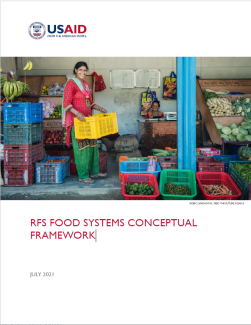The U.S. Global Food Security Strategy defines food systems as “the intact or whole unit made up of interrelated components of people, behaviors, relationships, and material goods that interact in the production, processing, packaging, transporting, trade, marketing, consumption, and use of food, feed, and fiber through aquaculture, farming, wild fisheries, forestry, and pastoralism. The food and agriculture system operates within and is influenced by social, political, economic, and environmental contexts.” The Bureau for Resilience and Food Security (RFS) Food Systems Conceptual Framework was designed to articulate the contribution of the United States Agency for International Development (USAID) to strengthening food systems and provide high-level operational guidance to RFS staff globally, in line with our overall strategy to build more resilient communities and sustainably reduce hunger, malnutrition and poverty.
The framework illustrates how key elements of the agency’s work come together as part of the food system, specifically: agriculture-led economic growth, water, nutrition, and resilience. It was developed in consultation with staff from across RFS and included consultations with other USAID Bureaus and a team of external experts to ensure it is fully aligned with bureau priorities and represents the best of food systems thinking from across sectors and disciplines.
This framework is adapted from the food systems conceptual framework developed by the High Level Panel of Experts on Food Security and Nutrition (HLPE) in the 2017 report Nutrition and Food Systems. The RFS food systems conceptual framework features key components shown in the HLPE framework, including drivers (red), the food system (blue) and outcomes (brown).
Food System: Supply and Demand: Similar to the HLPE framework, the RFS framework can be read left to right, starting with Food System: Supply and Demand, which includes the components of food supply, food environment, and food and water utilization.

